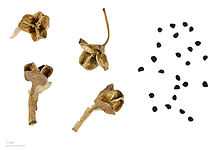Narcissus pseudonarcissus
| Narcissus pseudonarcissus | |
|---|---|
 | |
| Scientific classification | |
| Kingdom: | Plantae |
| Clade: | Angiosperms |
| Clade: | Monocots |
| Order: | Asparagales |
| Family: | Amaryllidaceae |
| Subfamily: | Amaryllidoideae |
| Genus: | Narcissus |
| Species: | N. pseudonarcissus |
| Binomial name | |
| Narcissus pseudonarcissus L. | |

Narcissus pseudonarcissus (commonly known as wild daffodil or Lent lily) is a perennial flowering plant which grows from a bulb. It has pale yellow flowers with a darker central trumpet. The long, narrow leaves are slightly greyish in colour and rise from the base of the stem.
Distribution
The species is native to Western Europe from Spain and Portugal east to Germany and north to England and Wales. It is commonly grown in gardens and populations have become established in many other parts of Europe. Wild plants grow in woods, grassland and on rocky ground. In Britain native populations have decreased substantially since the 19th century due to intensification of agriculture, clearance of woodland and uprooting of the bulbs for use in gardens. In Germany it was a subject of a national awareness campaign for the protection of wildflowers in 1981.
In England, in the North York Moors National Park, the Farndale valley hosts a large population of the species, along the banks of the River Dove.
In England, in Gloucestershire, there are several nature reserves supporting large populations of the species near Dymock Woods SSSI. There is a Daffodil Walk Trail around several reserves in the spring.[1][2]
Subspecies
There are a number of subspecies of the wild daffodil but the exact number varies according to different authors. The large number of cultivars adds to the difficulty of classification. Among the subspecies is the Tenby daffodil (N. p. ssp. obvallaris, sometimes classed as a separate species) which probably originated in cultivation but now grows wild in south-west Wales.
- ssp. pseudonarcissus - "Lent lily" / "Wild daffodil" - England and Wales
- ssp. eugeniae - Central Spain
- ssp. major- "Spanish daffodil" - Iberia
- ssp. pugsleyanus - Spain
- ssp. nevadensis - Iberia
- ssp. nobilis - "Large flower daffodil" - Iberia
- ssp. pallidiflorus - "Pale flower daffodil" - Spain and France
- ssp. portensis - Iberia.
- ssp. pugsleyanus - Spain
- ssp. obvallaris - "Tenby daffodil" - Southern Wales. (sometimes considered to be derived from relict cultivation of ssp. major [1] )
- ssp. radinganorum - SE Spain.
Emblem
The daffodil is the national flower of Wales, and also the County flower of Gloucestershire.[3]
Health risks
Like all Narcissus species, daffodils contain the alkaloid poison lycorine, mostly in the bulb but also in the leaves.[4][5] Hence they should never be eaten.
References
- ↑ 2011, 'Nature Reserve Guide', Gloucestershire Wildlife Trust published for its 50th anniversary
- ↑ 'The Daffodil Trails', (undated), Gloucestershire Wildlife Trust
- ↑ Plantlife website County Flowers page
- ↑ Food and nutrition Daffodil dinner David Trinklein, Department of Horticulture, University of Missouri, Accessed March 2008
- ↑ "Pupils ill after bulb put in soup". BBC News. 2009-05-03. Retrieved 2010-03-27.
External references
External links
![]() Media related to Narcissus pseudonarcissus at Wikimedia Commons
Media related to Narcissus pseudonarcissus at Wikimedia Commons